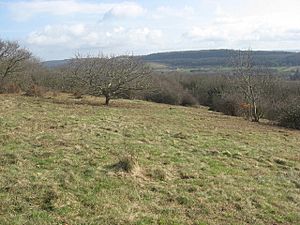Walton Common banjo enclosure facts for kids

Walton Common looking towards the banjo enclosure from the south west
|
|
| Location | Walton in Gordano |
|---|---|
| Region | Somerset |
| Coordinates | 51°27′35″N 2°49′27″W / 51.459645°N 2.824126°W |
| Type | Banjo enclosure |
| History | |
| Material | Earth |
| Founded | Iron age |
The Walton Common banjo enclosure is an ancient site found on Walton Common in Somerset, England. It's located north of a village called Walton in Gordano.
This site is called a "banjo enclosure" because of its unique shape. Imagine a round area with a long, straight path leading up to it. Both the round part and the path were surrounded by banks of earth and ditches.
Archaeologists believe this enclosure was built during the late Iron Age. It might have been a special settlement for important people. Over many years, the earth banks have worn down and the ditches have filled in. This makes it very hard to see the enclosure from the ground today.
However, old photographs taken from the air in 1930 and 1946 clearly showed its shape. Now, the area has become very overgrown, making it even harder to spot, even from above!
Where is the Banjo Enclosure?
The Walton Common banjo enclosure is on Walton Down, a hill near the village of Walton in Gordano. Its exact spot is marked as ST 4289 7377 on maps.
As mentioned, old aerial photos from 1930 and 1946 helped experts find the earth banks and ditches. Since then, lots of plants like gorse, scrub, and brambles have grown over the area. This has hidden many of the original features.
The site has also been changed by ant hills and rabbit burrows from the Middle Ages. These natural changes have made it even harder to see the ancient structure.
Interestingly, a survey in 1931 found two round burial mounds from the Bronze Age very close to the banjo enclosure. This shows that people have been living and using this area for a very long time.
What Was It Used For?
Similar banjo enclosures found in other places date back to the middle and late Iron Age. At first, some people thought these enclosures were used to keep farm animals like sheep. They might also have been seasonal camps for people who moved their animals around.
However, newer studies suggest that most banjo enclosures were actually places where people lived. They were likely homes for important or high-status people in the Iron Age.
The Walton Common enclosure is one of only four such sites identified in Somerset by English Heritage. It's also the easiest one to see from the ground because the land hasn't been farmed for many years. You can even reach it by following an old pathway that dates back to the Middle Ages!
What Does It Look Like?
The main part of the enclosure is shaped like an oval. It measures about 100 meters (about 328 feet) from west-southwest to east-northeast. It is about 88 meters (about 289 feet) from north-northwest to south-southeast. This oval area covers about 7,000 square meters (about 75,347 square feet).
A rampart, or wall, made of limestone blocks surrounds the enclosure. Most of these blocks are less than 0.76 meters (2.5 feet) high. Inside this, there's an inner bank about 2 to 3 meters (6.5 to 10 feet) wide. Outside the bank, there's a ditch that was originally 1 to 2 meters (3 to 6.5 feet) wide. Today, the ditch is only about 23 centimeters (9 inches) deep, and the banks are about 0.3 meters (1 foot) high.
There are two entrances to the enclosure. One is on the south side, and the other is on the northeast side. Paths made of parallel banks lead up to these entrances.
Two parallel banks stretch out about 150 meters (492 feet) from the northeast side of the enclosure. These banks are each about 2 meters (6.5 feet) wide and are spaced about 8.5 to 9 meters (28 to 29.5 feet) apart. At the end of this path, another earth bank crosses it at a right angle. This crossing bank is about 3 meters (10 feet) wide and 81 meters (266 feet) long, with a 4-meter (13-foot) gap in the middle.
The 1946 aerial photograph also showed what looked like a bomb crater in the long path leading to the enclosure.
About 70 meters (230 feet) southwest of the banjo enclosure, there's another smaller enclosure. It's shaped like a rhomboid (a slanted square) and measures about 46 by 30 meters (151 by 98 feet). This one also has earth banks and ditches.


